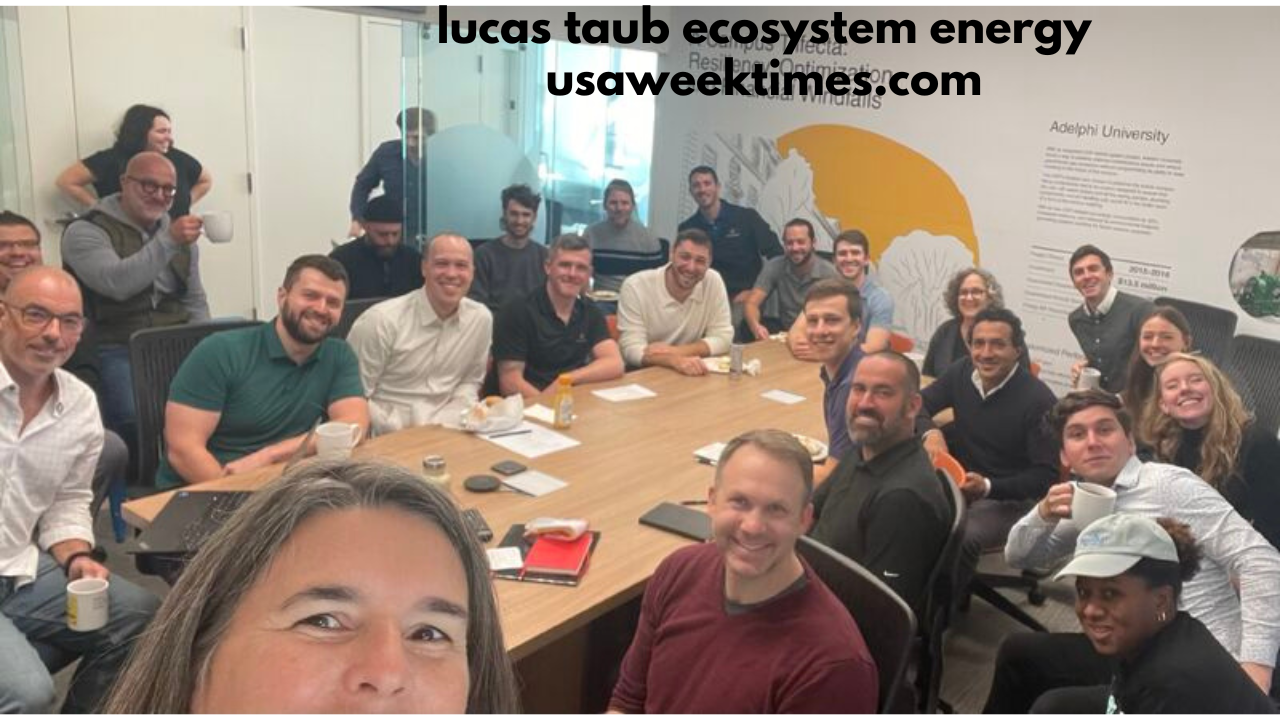Lucas Taub Ecosystem Energy: A Revolution in Sustainable Power, Environmental Impact, and Technological Innovations
Introduction: The Rise of Lucas Taub Ecosystem Energy
In the modern world, where environmental concerns are at an all-time high, the need for sustainable and renewable energy solutions has never been more urgent. The development of new technologies and systems that focus on cleaner and more efficient energy sources is paramount. Among the many innovations in the energy sector, one that has emerged with potential to reshape the way we view energy production and consumption is the Lucas Taub Ecosystem Energy. This concept brings together advanced energy solutions with a focus on ecosystem preservation, environmental sustainability, and technological advancement.
In this article, we will dive deep into the intricacies of Lucas Taub Ecosystem Energy, exploring how it functions, its role in addressing climate change, and its potential for transforming the global energy landscape.
What Is Lucas Taub Ecosystem Energy?
The term Lucas Taub Ecosystem Energy refers to a holistic approach to energy production, consumption, and management that prioritizes ecosystem health. It is a concept that integrates renewable energy technologies with environmental conservation efforts to create an energy model that works in harmony with nature. Named after Lucas Taub, an innovator in the field of sustainable energy, this ecosystem energy framework is rooted in the idea that technology should not only serve human needs but also preserve the delicate balance of the Earth’s ecosystems.
Lucas Taub, a visionary in the field of energy and environmental studies, has emphasized the importance of creating energy solutions that are not merely focused on reducing carbon emissions but also on enhancing biodiversity and ecosystem services. His ecosystem energy model combines the power of renewable energy sources like solar, wind, and hydropower with innovative systems that aim to minimize environmental disruption and foster biodiversity.
The Core Principles of Lucas Taub Ecosystem Energy
The Lucas Taub Ecosystem Energy framework is built on several core principles that are fundamental to its success:
- Integration of Renewable Energy Sources: At the heart of the system is the use of renewable energy sources such as solar, wind, geothermal, and hydropower. These sources are pivotal in reducing the reliance on fossil fuels, which are major contributors to climate change.
- Ecosystem Conservation: Unlike conventional energy systems that often lead to environmental degradation, Lucas Taub Ecosystem Energy places a strong emphasis on conserving natural habitats. The design of these energy solutions takes into account the local ecosystem, ensuring that energy production does not disrupt wildlife, water sources, or soil integrity.
- Technology and Innovation: The integration of cutting-edge technologies is a key aspect of this ecosystem energy model. Smart grids, energy storage systems, and AI-powered monitoring tools are incorporated to optimize energy distribution and ensure that energy systems are both efficient and sustainable.
- Community Empowerment: Lucas Taub Ecosystem Energy goes beyond environmental goals by focusing on social sustainability. The model promotes local energy solutions that empower communities to produce their own renewable energy, thereby enhancing energy access, reducing costs, and fostering self-sufficiency.
The Role of Renewable Energy in the Ecosystem Model
Renewable energy plays a pivotal role in the Lucas Taub Ecosystem Energy approach. Solar, wind, and hydropower are not only clean energy sources but are also integral to creating a balanced ecosystem energy system. The use of these resources ensures that the energy generated is low-carbon and sustainable, reducing the overall environmental footprint of energy production.
Solar power, for instance, can be harnessed in areas that have high levels of sunlight, while wind power can be efficiently generated in regions with constant air currents. Hydropower, on the other hand, taps into the natural flow of water, converting the kinetic energy of moving water into electricity. These renewable resources, when utilized in harmony, can provide stable and consistent energy production.
Moreover, renewable energy sources help mitigate climate change by reducing the need for fossil fuels, which release harmful greenhouse gases into the atmosphere. The shift toward renewables is a fundamental component of the Lucas Taub Ecosystem Energy system, as it aligns with the overarching goal of reducing human impact on the environment.
Environmental Benefits of Lucas Taub Ecosystem Energy
One of the most compelling reasons for adopting Lucas Taub Ecosystem Energy is the significant positive impact it has on the environment. Traditional energy systems, particularly those relying on fossil fuels, contribute to environmental degradation in various forms—air pollution, habitat destruction, deforestation, and climate change. The ecosystem energy model addresses these issues head-on by emphasizing the following environmental benefits:
- Reduction in Carbon Emissions: By shifting to renewable energy sources, the Lucas Taub Ecosystem Energy model drastically reduces the carbon emissions associated with energy production. This, in turn, helps combat global warming and climate change.
- Preservation of Natural Habitats: Lucas Taub’s model carefully considers the ecological impact of energy production. For example, solar farms and wind turbines can be placed in locations where wildlife and plant life are minimally impacted, preserving natural habitats while still generating power.
- Water Conservation: Hydropower, a key element of the ecosystem energy model, can be designed to have minimal impact on water ecosystems. Unlike conventional dams, which often disrupt water flow and fish migration, newer hydropower technologies focus on maintaining water quality and aquatic life.
- Biodiversity Enhancement: The focus on ecosystem health means that the Lucas Taub Ecosystem Energy model actively works to protect and enhance biodiversity. Whether through land restoration projects or sustainable agriculture practices integrated with energy systems, the model contributes to preserving species diversity and ecosystem resilience.
Technological Innovations Driving the Ecosystem Energy Model
The implementation of Lucas Taub Ecosystem Energy is made possible through advancements in technology that improve both the efficiency and scalability of renewable energy systems. Some of the key innovations driving this model include:
- Smart Grid Technologies: These grids are capable of managing and optimizing the distribution of renewable energy, ensuring that electricity is supplied where it is needed most. The intelligent management of power flow helps reduce energy waste and ensures more efficient usage of renewable resources.
- Energy Storage Solutions: One of the main challenges with renewable energy sources like solar and wind is their intermittency. However, advancements in energy storage technologies, such as batteries and thermal storage, allow energy to be stored when it is abundant and used when demand is high. This ensures a reliable and consistent energy supply.
- AI and Data Analytics: The integration of artificial intelligence and data analytics into energy systems allows for better decision-making in terms of energy generation, storage, and consumption. AI-powered monitoring tools can predict energy demand patterns and adjust supply accordingly, making the entire system more efficient and cost-effective.
Social and Economic Impact: Empowering Local Communities
Lucas Taub Ecosystem Energy is not only an environmental and technological initiative; it is also a social one. The model promotes community-led energy solutions, allowing local populations to have a stake in their energy production. This empowerment comes in several forms:
- Decentralized Energy Production: Local communities can set up their own renewable energy systems, such as small solar or wind farms, to meet their energy needs. This reduces dependence on centralized power grids and lowers energy costs.
- Job Creation: The transition to renewable energy creates new industries and jobs. From the construction of energy infrastructure to the maintenance of energy systems, the Lucas Taub Ecosystem Energy model fosters employment opportunities in green technologies.
- Economic Growth: By enabling communities to produce and manage their own energy, the model encourages economic self-sufficiency. Furthermore, the widespread adoption of clean energy technologies can stimulate broader economic growth, especially in emerging markets.
Challenges and Future of Lucas Taub Ecosystem Energy
While the Lucas Taub Ecosystem Energy model offers great promise, there are challenges to overcome. These include high initial investment costs, the need for large-scale infrastructure development, and political barriers in some regions. However, with continued technological advancements, government support, and global cooperation, the model holds the potential to revolutionize the energy sector.
As we move towards a more sustainable future, the Lucas Taub Ecosystem Energy approach stands as a beacon of innovation, offering solutions that balance technological progress with ecological responsibility. By fostering a symbiotic relationship between energy production and environmental conservation, it paves the way for a greener, more sustainable world.
Conclusion: A Bright Future for Ecosystem Energy
Lucas Taub Ecosystem Energy offers a transformative vision for the future of power generation and environmental stewardship. By combining renewable energy sources, cutting-edge technology, and a commitment to preserving ecosystems, it represents a holistic approach to energy that can help mitigate climate change, preserve biodiversity, and promote social equity. While challenges remain, the ongoing advancements in technology and growing global commitment to sustainability suggest that this ecosystem energy model will play a pivotal role in shaping the future of our planet.
As we continue to embrace the potential of Lucas Taub Ecosystem Energy, it is clear that this is not just an energy solution—it is a blueprint for a more sustainable, resilient, and prosperous future for all.




